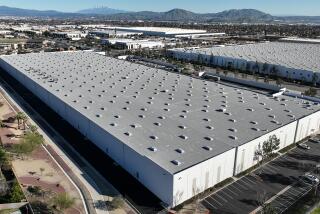Carson Gets Hearing on Sound Wall
- Share via
Carson residents who have unsuccessfully demanded state-funded freeway sound walls will have a chance to air their grievances this month when Caltrans holds a public hearing into the controversy at the request of Sen. Ralph Dills (D-Gardena).
Some older Carson neighborhoods are within a few yards of the San Diego Freeway but have been told they must wait several years for a sound wall.
Two weeks ago, Carson resident Warren Kimball delivered dozens of petitions signed by residents to Dills’ Sacramento office and asked that he look into the methods used by the California Department of Transportation in deciding which communities get sound walls first.
“I’m going to kick this thing around,” said Kimball, a retired aerospace engineer who led the petition drive. “We are not getting the proper attention for an issue that affects a lot of voters. We live with one hell of a noise out there.”
A Long Waiting List
To qualify for a sound wall, which costs about $1 million per mile, freeway noise in a neighborhood must reach 67 decibels, about the level of a small vacuum cleaner. About 237 communities in California are awaiting sound walls, but many, including neighborhoods in Carson, are so low on the state’s funding priority list that they will not get a wall until after the year 2000.
“We got quite a large stack of signatures, and these people want to see what just exactly they can do to get a sound wall,” said Frank Mitchell, an aide to Dills. “The residents have not had an opportunity to meet face to face with Caltrans, and this will give them that chance.”
The hearing is set for March 21 at 10 a.m. at Carson City Hall.
Kimball complained that Caltrans is ignoring its own regulations, which he said give the highest priority for sound walls to neighborhoods that existed before freeways were built. His neighborhood along 221st Place east of Alameda Street was constructed in the 1940s and 1950s, and the freeway was built in the 1960s.
Other Vital Factors
However, Caltrans officials have said that other factors are considered when a neighborhood is ranked on the waiting list.
Factors that earn a neighborhood a higher priority include a large population, whether sound reduction would be significant with a wall and whether the physical layout lends itself to an inexpensive or expensive wall.
Kimball said he purchased a sound decibel meter and tested his neighborhood at several times of day.
He said his recordings, which are not considered by Caltrans to be official readings, show that his street is noisier than 67 decibels. His street parallels the San Diego Freeway at a distance of 50 to 70 feet.
Carson Conducting Study
“To get a reading below 67 decibels, I had to cross my street, walking away from the freeway to the houses across from us,” Kimball said. “At some points, I had to go even farther, past those houses, to get the level to drop below 67.”
The city of Carson, at the request of several residents, is conducting a sound study to verify whether sound levels in that neighborhood have been understated by Caltrans.
Caltrans officials say that, based on numerous sound readings they have taken in the area, the neighborhood qualifies for a sound wall. But, they say, it is not as noisy as scores of other communities that are ranked higher on the state’s priority list.
More to Read
Sign up for Essential California
The most important California stories and recommendations in your inbox every morning.
You may occasionally receive promotional content from the Los Angeles Times.













